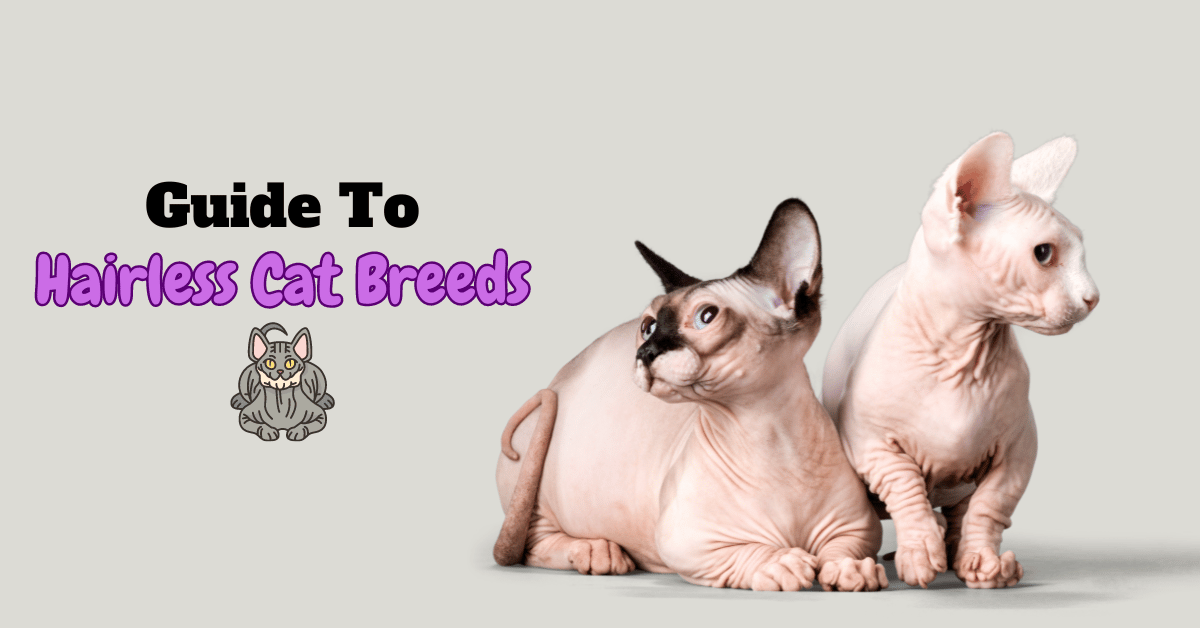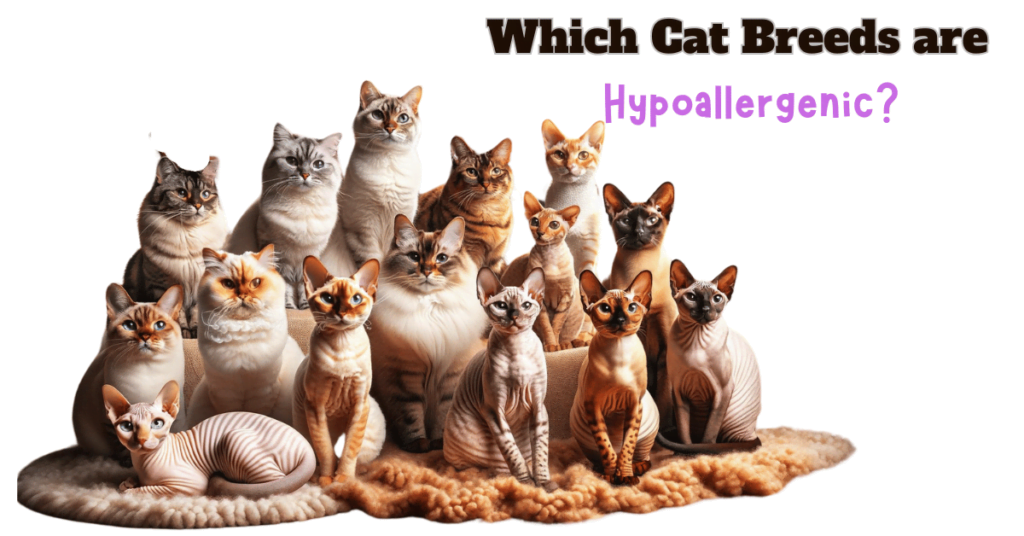This post contains affiliate links and I will be compensated if you make a purchase after clicking on my links.
Guide to Hairless Cats: Unveiling the Distinct Beauty and Traits
Explore the world of hairless cats, a group of breeds celebrated for their unique appearances and charming personalities. These cats are more than mere pets; they are engaging companions who often become integral members of their families.
This guide offers an in-depth look at hairless cat breeds, shedding light on their care, personalities, and how they might fit into your home and heart.
Hairless Cat Breeds Overview
Sphynx
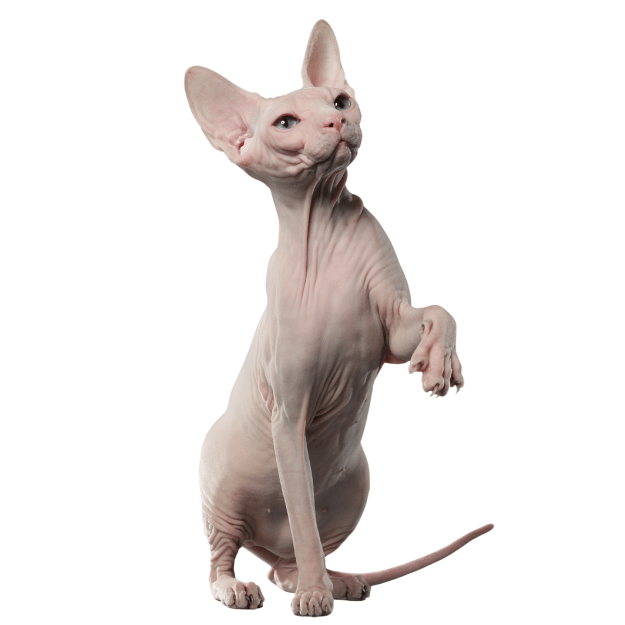
Sphynx
Origin: Canada, 1960s
Traits: Extroverted, high energy, wrinkled skin
The Sphynx is perhaps the most iconic hairless breed, celebrated for its extroverted behavior and high energy levels. Originating in the 1960s in Canada, this breed is characterized by its lack of fur, although it possesses a fine layer of down which gives the skin a soft texture. The Sphynx is known for its wrinkled skin, large lemon-shaped eyes, and oversized ears, giving it an eternally curious expression.
Donskoy
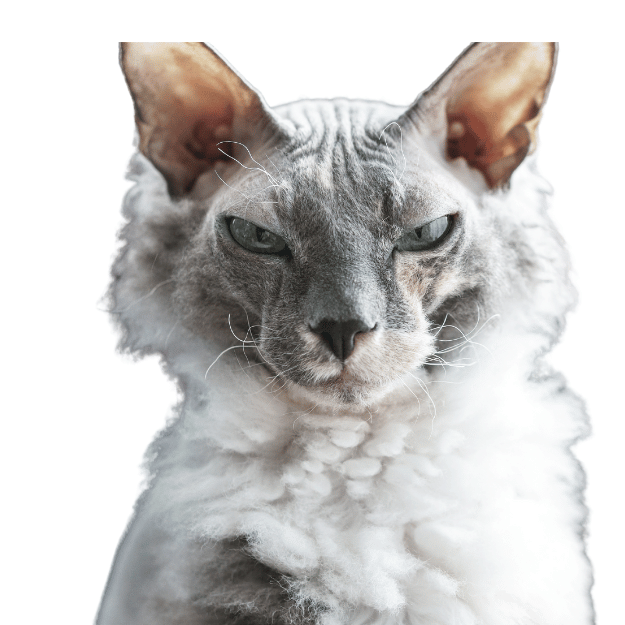
Donskoy
Origin: Russia, 1980s
Traits: Large ears, muscular, warm skin
This Russian breed, also known as the Don Sphynx, began its breed journey in the 1980s. Unlike the Sphynx, the Donskoy’s hairlessness is due to a dominant gene. This breed features large ears, almond-shaped eyes, and a muscular build. Its skin is wrinkly, particularly around the head and neck, and feels warm and soft to the touch.
Peterbald
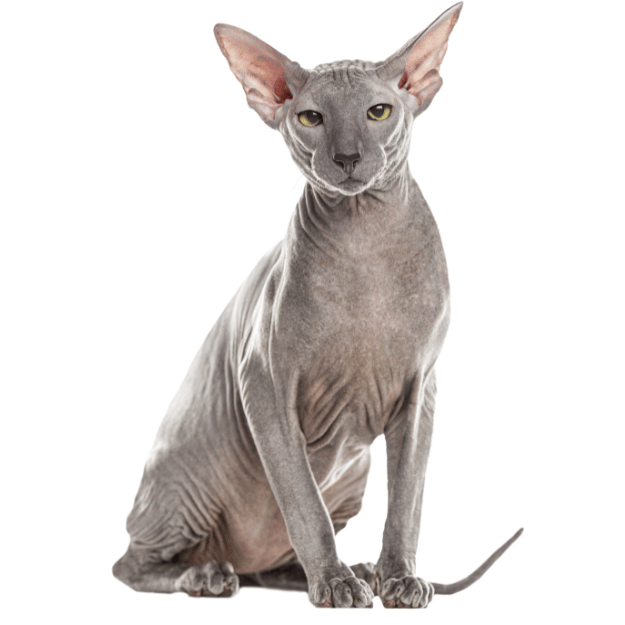
Peterbald
Origin: Russia, 1990s
Traits: Slim, muscular, varied coat types
Emerging in Russia during the 1990s, the Peterbald shares similarities with both the Sphynx and oriental breeds, resulting in a cat that is slim and muscular with a distinctive elongated head. They can range from bald, to a velvety fuzz, to a brush coat with some hair.
Ukrainian Levkoy
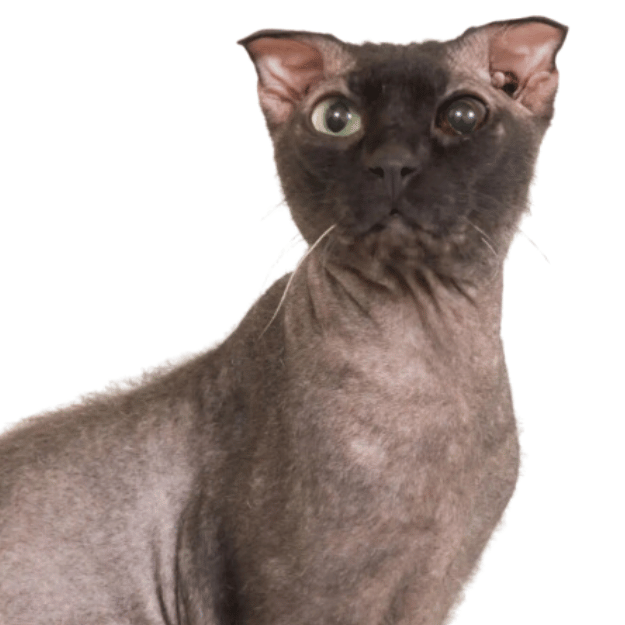
Ukrainian Levkoy
Origin: Ukraine, 2000s
Traits: Folded ears, sociable
Known for its folded ears, which it inherits from the Scottish Fold, and a hairless body from the Sphynx, the Ukrainian Levkoy is distinctive and angular. This breed was developed in the early 2000s and has a friendly, sociable temperament, making it a great companion.
Elf Cat
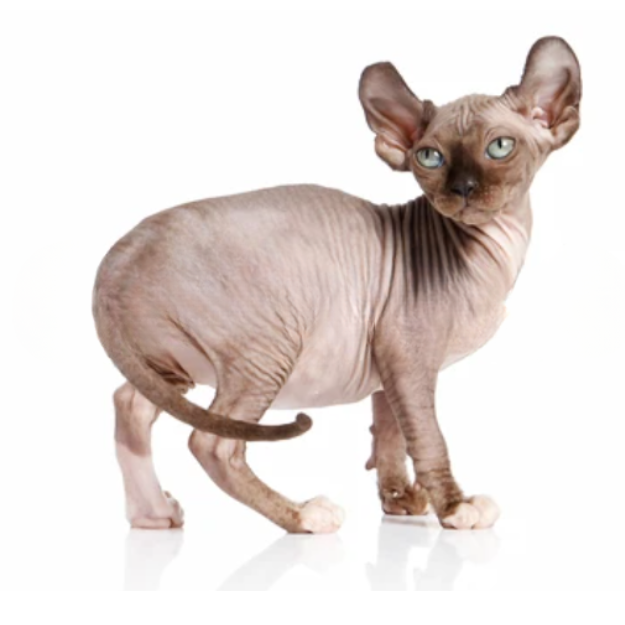
Elf Cat
Origin: USA, 2000s
Traits: Curled ears, friendly, playful
A unique breed that combines the hairless trait of the Sphynx with the curled ears of the American Curl, the Elf cat is a friendly and playful breed that emerged in the United States in the early 2000s. Their ears give them an elf-like appearance, hence the name.
Bambino
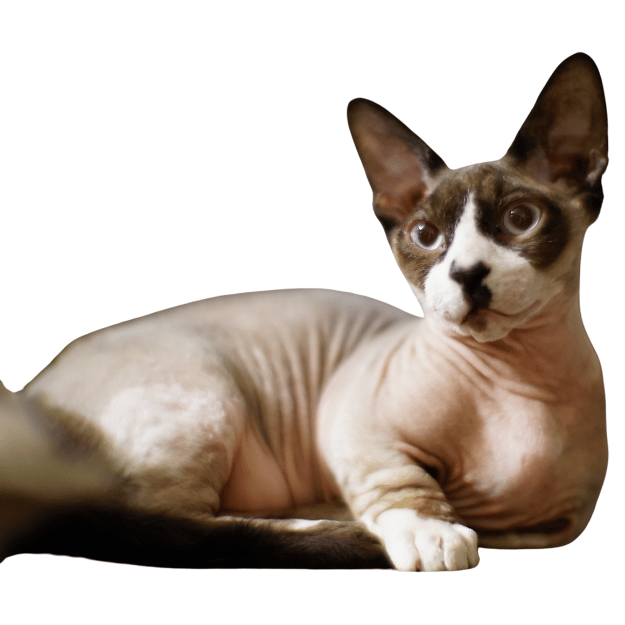
Bambino
Origin: USA
Traits: Short stature, kitten-like demeanor
This breed is a delightful combination of the Sphynx and the Munchkin, known for its short stature and hairless body. The Bambino is friendly and maintains a kitten-like demeanor throughout its life, making it a perpetual favorite among cat enthusiasts.
Other Lesser-Known Breeds
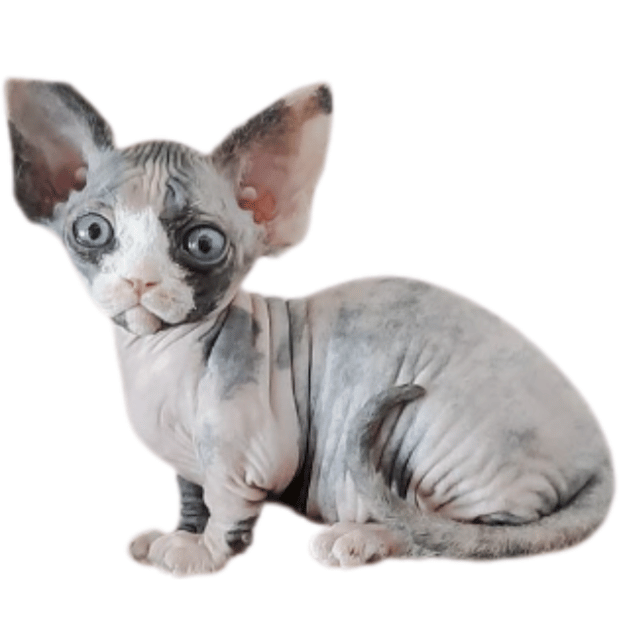
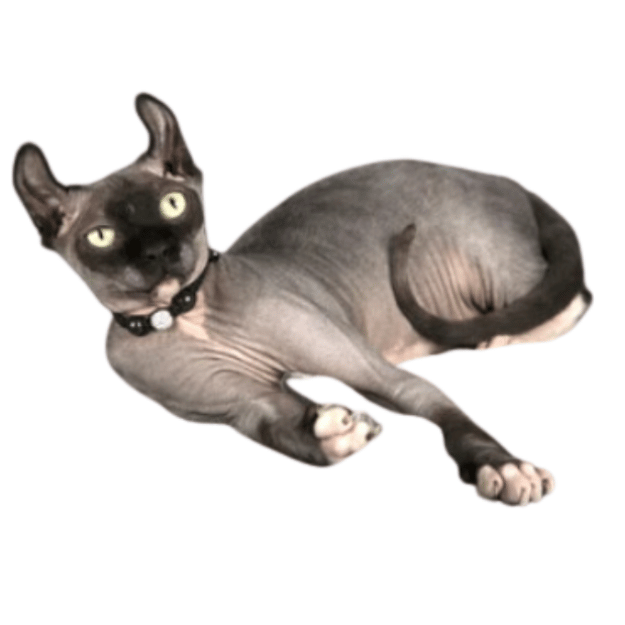
Briefly touching on breeds such as the Minskin and Dwelf, which are less common but equally captivating, each offers unique traits that may appeal to different prospective cat owners.
Understanding the Unique Nature of Hairless Cats
Hairless cats are not just visually striking—they bring a unique blend of personality traits that make them more than just pets; they are truly members of the family.
Known for their warmth-seeking behavior, these cats often find the sunniest spots in the house or might be found snuggled under blankets. Their lack of fur makes them particularly affectionate, as they seek out warmth and comfort from their human companions, often curling up in laps or resting against their owners.
Personality and Social Traits
Beyond their physical characteristics, hairless cats are renowned for their outgoing and sociable natures. They are playful and energetic, thriving on interaction.
Unlike more independent cat breeds, hairless cats are often compared to dogs in their desire for company and attention, exhibiting loyalty and a keenness to participate in household activities. They are vocal communicators, using chirps and meows not just to express needs but also to engage in conversations with their owners.
The Care They Need
Caring for hairless cats involves a few special considerations to ensure their comfort and health. Regular bathing is essential to manage the natural oils on their skin, which can build up and contribute to skin problems. Using a gentle, cat-safe shampoo during weekly baths helps keep their skin clean and healthy. In some cases, a light moisturizer may be needed to prevent dryness, particularly in less humid environments.
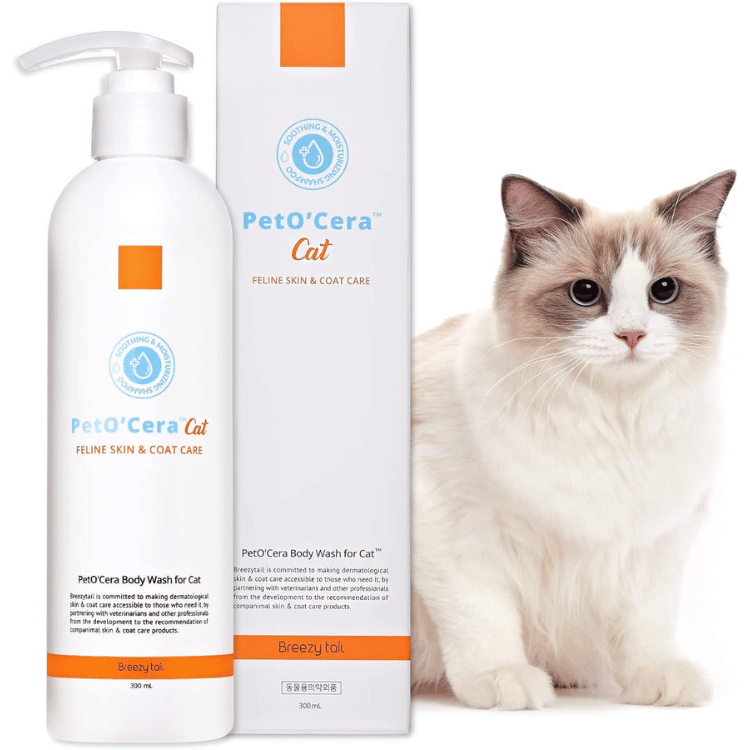
Temperature regulation is crucial for hairless breeds. Their lack of insulation means they can easily become cold, so providing warm, cozy spots around the home is necessary. During colder months, they may appreciate sweaters or small blankets. Conversely, in warm weather, ensuring they have cool, shaded places to rest is vital to prevent overheating.
Sun protection is another key aspect of their care. These cats can be prone to sunburn, particularly those with lighter or white skin, so limiting direct exposure to sunlight and using pet-safe sunscreen can help protect them.
Nutritional Needs
When it comes to diet, hairless cats typically have higher energy needs than their furry counterparts. A high-quality, protein-rich diet helps meet their metabolic requirements. Ensuring they stay hydrated is also crucial, which can be supported by incorporating wet food into their diet alongside providing constant access to fresh water.

Engaging Their Minds
Finally, like any cat, hairless breeds need mental stimulation and physical exercise. They enjoy climbing, exploring, and playing, so access to cat trees and interactive toys is beneficial. Engaging them with puzzle toys and regular playtime not only keeps them physically fit but also mentally sharp, helping to prevent boredom and maintain their overall well-being.
Health Considerations for Hairless Cats
Hairless cats, while robust in personality, do come with some breed-specific health issues that require careful attention. Regular veterinary checkups are paramount to monitor their well-being and catch any potential health issues early.
Common Health Issues
One significant concern for hairless breeds like the Sphynx and Peterbald is hypertrophic cardiomyopathy (HCM), a form of heart disease that is prevalent in these breeds. Regular heart screenings are recommended to detect any signs of this condition early.
Skin problems are also more common in these breeds due to their lack of fur. Their exposed skin can be prone to acne, yeast infections, and even sunburn, making regular skin assessments a part of their routine care.
Due to their sensitivity to cold and overexposure to the sun, hairless cats can experience discomfort or health issues related to extreme temperatures. Their unique physiology requires that owners are vigilant about their environment, ensuring they are neither too cold nor too hot.
Specialized Veterinary Care
It’s advisable for owners to seek veterinarians who have experience with hairless breeds. These professionals will be better equipped to handle the specific challenges that come with these cats, from skin care regimens to managing their predisposition to certain ailments. They can also provide valuable guidance on preventative care measures that can greatly enhance the quality of life for these cats.
Living with a Hairless Cat
Adopting a hairless cat is more than just enjoying their endearing quirks; it involves a commitment to their special needs. The hairless cat’s sociable nature makes them excellent companions.
They integrate well into various household dynamics, whether they are joining a single-person home or a family with children and other pets. However, their need for interaction means they do best in environments where they can receive plenty of attention and affection.
Preparing Your Home
Creating a safe and comfortable space for a hairless cat involves more than just providing toys and a litter box. Ensuring that your home is equipped with areas where they can stay warm and retreat from the heat is crucial.
This might mean investing in heated pet beds, safe heating pads, and cozy hideaways. Likewise, during the warmer months, providing a cool environment with ample shade and access to cool surfaces can help prevent overheating.
Myths vs. Reality
It’s important to debunk some common myths about hairless cats. While often touted as hypoallergenic due to their lack of fur, they can still produce allergens through their skin and saliva. Prospective owners with allergies should spend time with a breed to truly understand their personal reaction before making a commitment.
Finding a Hairless Cat: Breeders and Adoption
Choosing a Reputable Breeder
When deciding to bring a hairless cat into your family through a breeder, it’s essential to choose someone who upholds the highest standards of ethical breeding. Here’s what to look for in a reputable breeder:
- Health Screening: A good breeder will provide health clearances for the kittens and their parents, particularly for conditions common in hairless breeds like hypertrophic cardiomyopathy and skin issues.
- Environment: Visit the breeding facility if possible. The environment should be clean, safe, and well-organized, with plenty of space for the cats to play and relax.
- Transparency: Ethical breeders will be transparent about their breeding practices and the lineage of their cats. They should be willing to answer any questions about their methods and the breed.
- Aftercare Support: Look for breeders who offer ongoing support after you take your kitten home. This includes advice on care, feeding, and health.
Adoption Options
Adoption is a wonderful way to offer a hairless cat a loving home. Many hairless cats in shelters or rescue organizations are looking for their forever homes and can make just as wonderful companions as those bought from a breeder.
- Rescue Groups: Specialized rescue groups for hairless breeds often have cats who need homes. These groups are knowledgeable about the breed and can help match you with a cat that suits your lifestyle.
- Shelters: Don’t overlook local shelters; occasionally, they receive hairless cats and are in need of adoptive families.
- Adoption Events: Attend adoption events where you can meet hairless cats in need of homes and speak directly with foster carers who understand their specific needs.
Guide to Hairless Cats: Steps to a Happy Life with Your Hairless Cat
Hairless cats are not just unique in appearance—they bring immense joy, companionship, and a hint of quirkiness to your life. Whether you choose a Sphynx, a Peterbald, or any of the other breeds, preparing your home and your heart for such a companion requires thoughtful consideration of their needs and how well they align with your lifestyle.
We hope this guide has provided you with the information needed to make an informed decision about adopting a hairless cat. Remember, these enchanting creatures require dedicated care, so don’t forget to equip yourself with the right products to cater to their needs.
Check out our Hairless Cat Product Catalog to find everything you need to keep your new friend happy and healthy. The rewards of their affection and distinctive presence in your home are immeasurable.
Meet Sean, a fintech whiz with a penchant for pet purrs and blockchain buzz. After a decade of fintech feats, Sean’s tech talents leaped from ledger lines to litter lines, driven by a passion for pets and a vision for a more connected pet care community. With three critter companions as co-pilots, Sean launched this blog to share a treasury of pet-friendly tech tips and tales.

